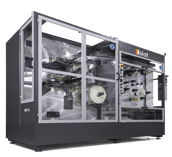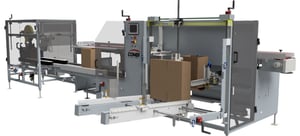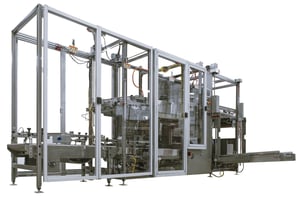At most companies, the arrival of new automation equipment is a rare occurrence. More often than not, that equipment is for production and assembly. So when a massive end-of-line (EOL) packaging system is delivered, it may be startling or even unsettling.
“Especially when a company is going from hand-packing to full automation, they can get overwhelmed when the equipment arrives – and more so when they see everything that goes into setting it up and getting it ready to run,” says Cory Hosner, Senior Service Technician at Combi Packaging. “They’re feeling like this big monster is never going to work.”
That was the mood Hosner describes at a recent installation for a cookie company. “The product is fragile and had been packed completely by hand,” he says. “They bought one of our big lines, and when they were watching it being assembled, there was a lot of skepticism. They were certain this huge machine was going to make crumbs out of everything. By the time we left, they couldn’t believe how fast and smooth everything worked.”
So aside from jitters and doubts, here’s what you can expect when new automation equipment arrives from Combi.
Pre-Installation
Installation preparation begins well before equipment is even shipped.
First, it undergoes a factory acceptance test (FAT) on the Combi plant floor. That involves more than turning on the equipment and making sure it works.
The buyer has already provided its own products and case blanks, and these are used in the FAT to ensure there are no unexpected compatibility issues. If the line will be used for packing multiple SKUs, it gets tested across all of them. Changeover settings are calibrated and documented – which makes for faster training and startup once the equipment has been installed.
At the install site, the buyer has four main to-dos:
- Contracting a rigging crew with the appropriate state (and sometimes local) contractor’s license to accept and install the machines.
- Installing compressed air and electrical hookups. The rigging crew may handle this if it has the experience and indicated licensure. Otherwise, the job is generally farmed out to another contractor certified for that work.
- Clearing the installation area of any other machinery, materials and activity. “If they’re using that area now for hand-packing, they’ll either have no production during the installation period, or they’ll have to relocate the active packing operations to another area of the facility,” Hosner says.
- Assuring availability of a forklift capable of moving the equipment. It’s a routine occurrence that the forklift used for day-to-day operations is underrated for the job, which means renting one with higher capacity.
Details and specifications to meet these requirements are shared by Combi’s customer care team well before the new machinery is shipped.
Installation
Machines arrive from the factory fully wrapped and secured to one or more skids – depending on the specific equipment. The customer or rigging crew unwraps it, checks for damage during transport then moves it to the install area.
It takes 2-3 days to assemble a standalone case erector/case sealer and integrate it with existing equipment. Larger systems, especially those with robotics or pick-and-place capabilities, may require a week or so.
“If our machine is going to become part of a line that involves equipment from other OEMs, the installers will make sure the line height is consistent across the entire setup,” Hosner says. “If we’ve provided an end-to-end system, the line heights and other critical measurements are set at the factory, which really speeds things up.”
Typically, Combi’s service technician arrives as assembly is being completed. Some buyers will contract to have him on-site to oversee the entire process, “but we officially take over once the equipment is fully assembled and connected to air and power,” Hosner says. “At that point, we check voltage, flip on the breaker and run our own startup check.”
Testing & Commissioning:
Once the machinery is ready to run, “we’ll ask the customer what SKU they want to start production on first,” Hosner says. “We’ll get the machine set up for that product and case, and then have them start running the upstream machines so we can begin testing at 20% speed.”
As fine-tuning continues, the system is gradually ramped up to the operating speed specified in the sales agreement. This can take a full day and sometimes part of the next.
Training
After the machine is ready to run at production speed, machine operators receive training in groups of four or five people at a time. The sessions take about two hours and include stops, starts, resets, clearing jams, removing misoriented product and changeovers.
“Some customers have their operators doing changeovers, and others only want maintenance techs doing that,” Hosner says. “Whichever is the case, we adapt our training to the specifics of your operation.”
Maintenance supervisors and managers are trained separately from operators. They get the same basics, plus a deeper dive into the HMI screen. These sessions run three or four hours.
“No matter what the company’s operating structure may be, one thing we want to make sure of is that access to the HMI is limited to people with the full training,” Hosner says. “I’ve had customers who chose to put the login info on the HMI itself, and that can open the door to all kinds of trouble.”
For example, there was the time when someone made an unauthorized change to the pick-and-place positioning that resulted in the moving head crashing into other parts of the machine, causing significant damage and shutting down the line.
Another time during testing at the Combi plant, rather than gently setting down a 4-gallon of mayonnaise, an error in the Y-axis settings caused the machine to flatten it like a pancake. “Let me tell you, four gallons of mayonnaise covers more ground than you might expect,” he says. “Even well-trained people who work with the HMI every day can make mistakes, so we really encourage restricting access.”
Monitoring and support
“After training, we step back and monitor production while the company’s own people are operating the equipment,” Hosner says. More questions usually arise, and there may still be some minor troubleshooting. “But the main point is to stand back and let them learn by figuring things out. So by the time we leave the facility, they know the machinery well enough to do some of their own problem solving.”
This is when any remaining skepticism about automation tends to fade away.
“By the end of the week, they’ve seen the precision and care that goes into the installation,” Hosner says. “They’ve seen the system at work. They’re looking at the numbers and see how it’s helping productivity. And they have a phone number to call so we can talk them through any issues that come up. They’re like, ‘Wow, this is amazing,’ and they aren’t looking back.”
If you’re considering upgrading your end-of-line packaging operations, contact Combi Packaging Systems to see what our superior technology and service can do for you.

.png?width=172&name=End%20of%20Year%20Sale%20Equip%20Drop%20Down%20(172%20x%20157%20px).png)






.png?width=161&name=ProWrap%20(1).png)


